The opioid epidemic has claimed hundreds of thousands of lives in the United States over the past two decades, devastating families and communities around the country. As this epidemic remains one of the nation's most severe public health crises, healthcare professionals continue to search for effective ways to save lives amid this tragedy.
In cases of an opioid overdose, rapid intervention is critical. Healthcare professionals have been pushing for the use of innovative technology, like drones, to deliver life-saving measures during these emergencies.
Miguel Lejeune, a professor of decision sciences and electrical and computer engineering at George Washington University, researched whether using drones could reduce response times and increase the chances of survival during overdoses.
In the study “Drone-Delivery Network for Opioid Overdose: Nonlinear Integer Queueing-Optimization Models and Methods,” co-authored with GW alumnus Wenbo Ma, M.S.’20, Lejeune compared the response rates of drones and ambulances in emergencies. Lejeune also developed mathematical optimization models to help cities decide where to establish drone bases, how many drones to position in advance and how to dispatch them for delivering medication in cases of drug overdoses.
“The opioid epidemic is a major health concern,” Lejeune said. “In the U.S., 2 million people encounter some issues with an overdose each year."
Lejeune explained that every second counts when trying to save the life of someone who is overdosing. Five minutes into an overdose, there’s a chance the person could suffer permanent brain damage. There’s also the risk of seizure, slowed breathing and cardiac arrest.
“Opioid overdoses can be lethal if you don't provide quick medical treatment,” Lejeune said. “Drones have been called the ‘magic bullet’ by many healthcare professionals who believe they will save lives in incidents such as an opioid overdose or a cardiac arrest,” Lejeune said.
Currently, when a bystander witnesses someone overdosing, they call 911 and wait for an ambulance to arrive so paramedics can administer naloxone to the victim.
The issue, Lejeune said, is that many cities face a shortage of ambulances, leading to delays in response due to factors like high demand or heavy traffic. In rural areas, the situation is even more challenging, with fewer ambulances and longer distances for emergency response units to travel.
To determine whether drones could respond quicker in cases of overdoses, Lejeune analyzed overdose data spanning two and a half years between 2017 and 2019 in the city of Virginia Beach, Virginia. He input that data into a prescriptive analytics mathematical model to determine what the response time would have been if drones were used. Lejeune used queuing-based optimization models in the study.
The findings revealed drones responded in about 1 minute and 30 seconds while an ambulance took 8 minutes and 56 seconds. In emergency, life or death scenarios where every second counts, that’s a significant difference, Lejeune said. “The chance of survival could become up to five times larger. A very significant increase,” Lejeune said.
According to the model, using drones in Virginia Beach could reduce response times by 82 percent, increase survival chances by over 273 percent and save 33 additional lives each year.
If drones were used in emergency scenarios, when 911 is called, dispatch would select a drone station and send a drone to the scene of the emergency. When the drone arrives at the scene, it lands and drops a package containing naloxone. Then, a bystander can administer the medicine with the guidance of a health professional who is observing the scene with the use of the live-video component on the drone.
Lejeune said research shows in emergencies such as this, most people are willing to administer medicine to help someone who has overdosed.
He said there have been many pilot programs that have explored using drone technology for emergency medical situations including deploying defibrillators in cases of cardiac arrest.
Before such programs can be implemented, there are challenges to overcome, Lejeune said. He identified obstacles such as many cities having no-fly zones, the public not wanting drones in their airspace and the possibility of technical issues, including operating drones under adverse weather conditions.
Despite these potential obstacles, Lejeune said exploring the use of this technology in emergencies has significant, lifesaving implications.
“This push for using drones very much comes from medical professionals,” Lejeune said. “They view it as a revolutionary, technological advance to respond to emergencies and believe that this could have a significant effect on improving the chance of survival of people having a medical emergency away from a hospital environment.”





